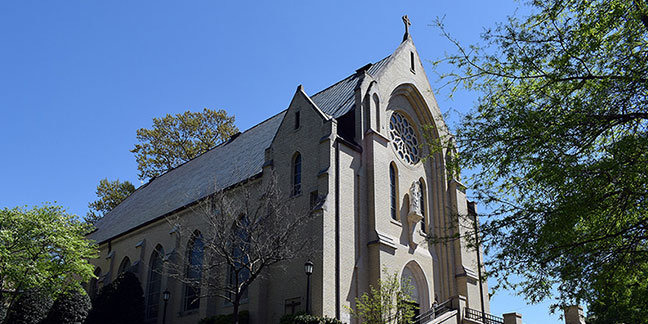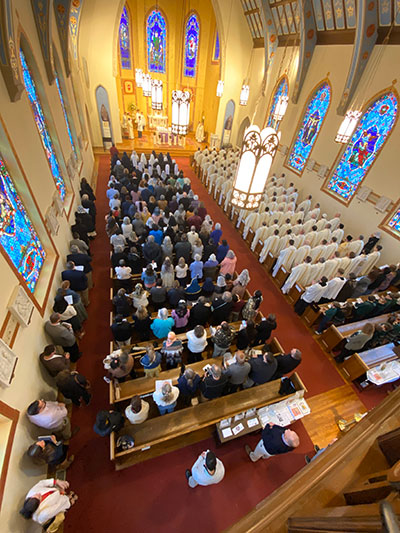 Built in 1939, St. Patrick Cathedral is among the smallest cathedrals in the U.S. and can no longer accommodate significant liturgical celebrations of the growing diocese. (File | Catholic News Herald)
Built in 1939, St. Patrick Cathedral is among the smallest cathedrals in the U.S. and can no longer accommodate significant liturgical celebrations of the growing diocese. (File | Catholic News Herald)
Bishop Jugis approves plan
CHARLOTTE — After 50 years of building up its parishes, schools and ministries, the Diocese of Charlotte is preparing to lay the final cornerstone of its foundation: a new cathedral.
Bishop Peter Jugis recently accepted the recommendation of a task force of Church and lay leaders to build a new cathedral to replace St. Patrick Cathedral, which was built as a parish church in 1939 and is no longer large enough to serve the growing diocese’s needs.
Still in its earliest planning stages, cathedral construction would not begin until 2030, though fundraising is expected to follow in the next few years. The cost and location have not yet been determined but a new site is necessary, the task force said. The cathedral should go on a “noble and attractive” site in Charlotte, the largest city and the “seat” of the diocese, which serves 46 counties in the western half of North Carolina.
“This is a defining moment for the Diocese of Charlotte,” said Bishop Peter Jugis, who recently celebrated his 20th anniversary as the diocese’s fourth bishop. “Since the diocese was established 52 years ago, we have invested significant resources in our 92 parishes and missions, 20 schools and more than 50 ministries. Now it’s time to provide a mother church where people from across our diocese can gather to worship Our Lord and celebrate our most important milestones.”
A new cathedral in Charlotte would follow a trend for the growing Catholic Church in the South.
Among 193 Catholic cathedrals across the U.S., 15 have been built or expanded within the past 40 years – including six in the South to serve growing Catholic populations of Hispanic families and people moving in from the Northeast and Midwest. Costs for cathedral construction have ranged widely from $31 million in Knoxville in 2018, to $190 million in Los Angeles in 2002.
“Most great cities have remarkable Catholic cathedrals, and Charlotte ought to be among them,” said Monsignor Patrick Winslow, vicar general and chancellor of the diocese, who served on the task force. “A cathedral is holy ground, built to endure the ages,” he said. “It serves as a singular nexus of communion: for the faithful with God, for the local Church with the universal Church, and for the local Church with its bishop, priests, deacons, consecrated religious, parishioners and community.”
New cathedral for a growing diocese
The 19-member task force was appointed more than a year ago to advise Bishop Jugis on whether the diocese needs a new cathedral and, if so, the timing of construction, location considerations and general specifications. Members included diocesan administrative, property and finance leaders, clergy, real estate advisors and lay leaders.
The task force unanimously concluded a new cathedral is needed due to the growth of the diocese and the inadequacy of St. Patrick Cathedral, and recommended that “all necessary preliminary work be done to allow construction to begin in 2030.”
Located in Charlotte’s historic Dilworth neighborhood, St. Patrick Cathedral is among the smallest in the U.S. with seating for 350 people, not much bigger than the cathedral in Juneau, Alaska.
St. Patrick wasn’t built as a cathedral – it was a parish church quickly elevated to serve as a cathedral when the diocese was established in 1972, and the Catholic population numbered about 30,000. The 85-year-old building recently underwent roof, drainage and other renovations to repair water damage to its aging ceiling and walls. Access and parking are also a challenge for the landlocked site.
St. Patrick has long been unable to accommodate the diocese’s most significant liturgical celebrations including the installation of three of the diocese’s bishops, and the ordinations of priests and deacons – liturgies that draw thousands of worshipers and have had to be diverted to other churches. St. Patrick is also too small to host all the clergy and laypeople who want to attend the annual Chrism Mass, when all the priests of the diocese gather with the bishop to renew their promises and bless the sacred oils used in parishes throughout the year.
“Everybody loves St. Patrick and it will continue to serve us well as a parish church,” Monsignor Winslow said, “but it no longer works as a cathedral for a diocese with more than half a million Catholics living and worshiping here.”
Cathedrals built recently in the United States generally seat between 1,000 and 3,000 people. The Cathedral of the Most Sacred Heart of Jesus in Knoxville, Tennessee, built in 2018, seats 1,358 people. The Diocese of Raleigh’s Holy Name of Jesus Cathedral, built in 2017, seats 2,000 people.
Mother church for the faithful
 A cathedral serves as the mother church of a diocese, where the faithful can worship with their bishop, and is regarded with great reverence as the center for liturgical life. It is the bishop’s ceremonial seat of authority and the physical location of his “cathedra,” which means “seat” in Latin, from which he presides.
A cathedral serves as the mother church of a diocese, where the faithful can worship with their bishop, and is regarded with great reverence as the center for liturgical life. It is the bishop’s ceremonial seat of authority and the physical location of his “cathedra,” which means “seat” in Latin, from which he presides.
It is typically at the cathedral that a diocesan bishop officiates at the more significant liturgical days, consecrates the sacred chrism (oil), and ordains deacons and priests.
“In the majesty of its building,” Monsignor Winslow said, “a cathedral is a symbol of the spiritual temple built by the people and resplendent with the glory of divine grace.”
For these reasons, a new cathedral should be located in a vibrant area, the diocesan task force advised, to serve as a visible sign of the Catholic presence in the community. It must be easily accessible by private vehicles and public transportation so that everyone has the opportunity to visit.
Diocesan leaders are now focused on identifying a site, architect, scope, and preliminary construction estimates to create a more detailed plan.
Several locations within the City of Charlotte are being considered, including repurposing the current Diocesan Pastoral Center location on South Church Street near uptown, diocesan leaders said.
It’s too early to determine fundraising plans, but finance and development officials say the diocese could consider selling land and other assets, leveraging investments, and seeking donations in a capital campaign.
Diocesan leaders hope to select a site by summer. They also recently invited a few select architects to study the history of the Church in western North Carolina, as well as its presence today, and submit proposals to design the new cathedral, also this summer.
Architects should consider, for example, the diocese’s immigrant roots, initially from Europe and more recently from Latin America. They must also understand the foundational work by the
Benedictines and the Sisters of Mercy to establish the Church, who were instrumental in starting parishes, schools and hospitals across the state.
Next steps are to build out a timeline and financing plans for a complex and extensive project that will take shape over the next six years.
Monsignor Winslow acknowledges the timeline is long – because this project is meant to be one for the generations, the final pillar of a foundation the diocese began building over 50 years ago.
The Church has attended to the needs of the faithful in North Carolina since long before the diocese was established, he said, when the state was considered “mission” territory and priests on horseback offered Mass in people’s homes. Since the diocese was formed in 1972, its four bishops have prioritized “the many and various needs of the faithful,” from its cities, towns and rural communities, fostering the physical and spiritual growth of the diocese.
“Our bishops, clergy and diocesan leadership have focused on building up the People of God and providing a spiritual home that has become one of vitality and strength,” Monsignor Winslow said. “It is now the responsibility of this generation to finish the work that began 50 years ago and lay the final cornerstone – with the construction of a cathedral that celebrates and serves the dynamic community of faithful we have become.”
— Liz Chandler


